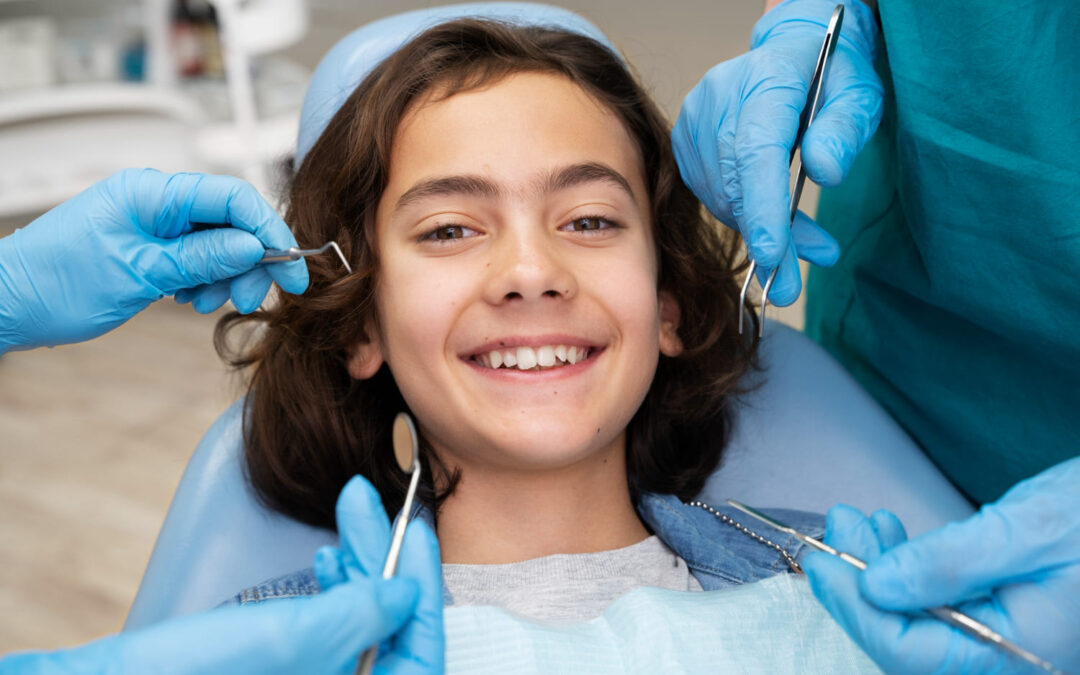As parents, we all want to make the best health decisions for our kids. If your little one’s permanent teeth are starting to emerge, you might be wondering if it’s the right time to take them for their first orthodontist visit — especially if you notice something off about their teeth or bite.
The magic number
Age 7 is typically the right time for that first orthodontic visit. At this age, kids have a mix of baby teeth and permanent teeth, making it easier for orthodontists to diagnose and predict dental issues that may arise in the future. This stage in dental development allows for early detection of common problems like crowding, overbites, or underbites.
Here are some key advantages of early intervention for your child:
- Timely interventions: Allows for timely treatments that can guide the growth of the jaw and proper spacing of the teeth.
- Less invasive treatments: This means less invasive treatments and less need for future corrections.
- Cost efficiency: Helps you avoid more expensive and lengthy procedures down the road.
- Better oral hygiene: Proper teeth alignment at a younger age can lead to better oral hygiene.
- Confidence boost: Fixing dental issues early can help boost a child’s self-esteem, especially during their formative years.
Does my child need orthodontic care?
Keep an eye out for these signs:
- Baby teeth falling out too early or late: This can lead to problems with emerging permanent teeth.
- Trouble chewing or biting: If eating seems hard for them, it might be due to the way their teeth line up.
- Crowded or out-of-place teeth: Easy to spot and a common reason for braces.
- Jaw sounds or pain: Any clicking or discomfort when moving the jaw could be a hint of joint problems.
- Biting inside of the cheek often: This could mean their teeth aren’t aligned right.
- Teeth not meeting properly: If there’s something off when they bite down, an orthodontist can help sort it out.
What to expect during a screening
Knowing what to expect can make the experience smoother for you and your little one. Here’s what typically happens during the visit:
- Welcome: The orthodontist and team will introduce themselves and make your child feel comfortable.
- Comprehensive examination: They will conduct a thorough examination of your child’s teeth and jaw, assessing any immediate needs or potential future issues.
- Discussion: After the exam, the orthodontist will discuss their findings and talk about potential treatment options or preventive measures.
- Informative Session: This visit is also educational, providing you with key insights into your child’s oral health and how to support it as they grow.
- No immediate decisions required: There is no pressure to make quick decisions. This screening is about understanding your child’s orthodontic health and planning for their future needs.
What we look for during screenings
Here are some common issues that orthodontists often identify during early visits:
Misaligned teeth
Misaligned teeth include crowding, gaps, or misplacement, impacting both smile aesthetics and oral functions. Early screenings help orthodontists design timely interventions to correct these issues, improving the child’s bite and ease of speaking and eating.
Bite problems
Early screenings identify bite problems like overbites, underbites, and crossbites, where teeth don’t align properly. Correcting these early can prevent complications such as jaw pain and functional difficulties later in life.
Jaw growth concerns
Screenings assess jaw growth to detect potential problems that may affect dental alignment and facial aesthetics. Early interventions can guide proper jaw development, avoiding more complex treatments down the road.
Oral habits
Screenings can uncover harmful oral habits, such as thumb sucking, which may cause teeth and jaw misalignment. Addressing these habits early helps prevent long-term orthodontic issues.
Pre-orthodontic guidance
Screenings guide what steps to take next, whether it’s monitoring, intervention, or reassurance. This helps in planning effective treatments and ensuring healthy dental development.
What is early interceptive treatment?
Early interceptive treatment, also known as Phase 1 orthodontics, is a proactive approach aimed at addressing and managing potential orthodontic issues in young children.
This treatment targets specific problems early, even while some baby teeth are still there, making future treatments simpler and less invasive. It’s designed to guide the development of the jaw and dental arches, improving the way permanent teeth will fit together.
Phase 1 orthodontic treatments are diverse and vary according to your child’s needs. Here’s what they might include:
- Expanders: These help make the jaw bigger to give teeth more room to align properly.
- Partial braces: Placed on certain teeth to fix early issues like crowded or crooked teeth.
- Space maintainers: Used to keep space open for the adult teeth when baby teeth fall out too soon.
- Special appliances: These devices help stop habits such as thumb sucking or tongue thrusting that can change the way teeth and jaws grow.
Set the foundation for a healthy smile with us

At Fairfield Orthodontics, we’re here to support your child’s health and smile. Dr. Niousha Saghafi, our board-certified orthodontist, brings a gentle touch and extensive experience in diagnosing and treating orthodontic issues from a young age.
Start with a free consultation to learn how we can help your child. Call us in Fairfield: (707) 428-3200.

